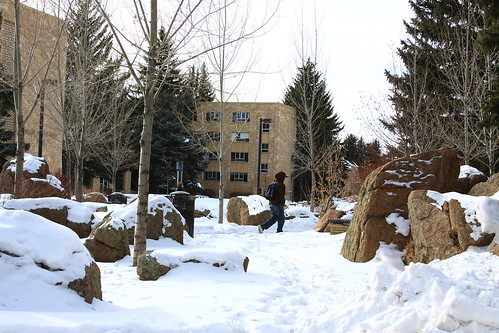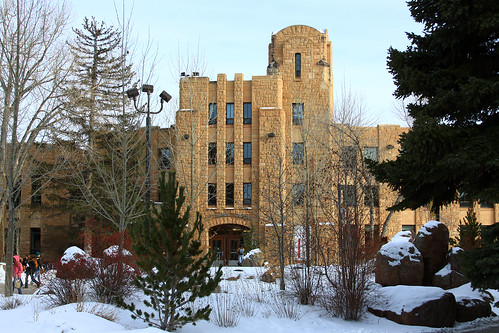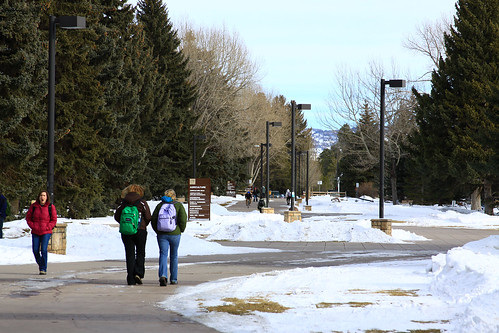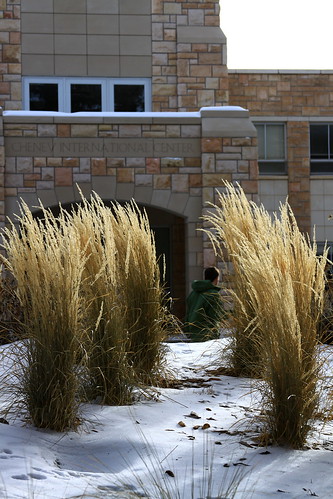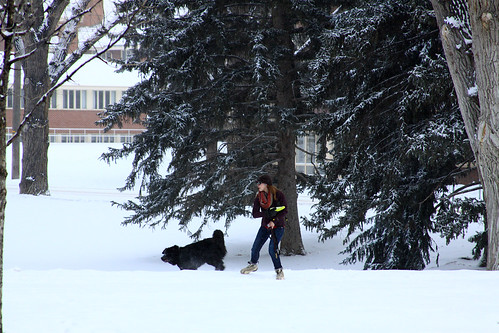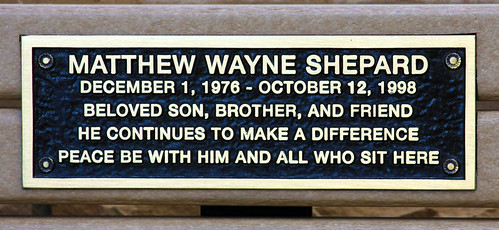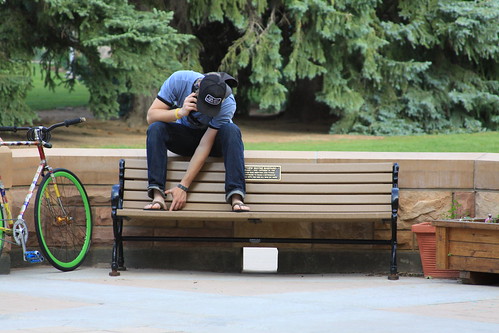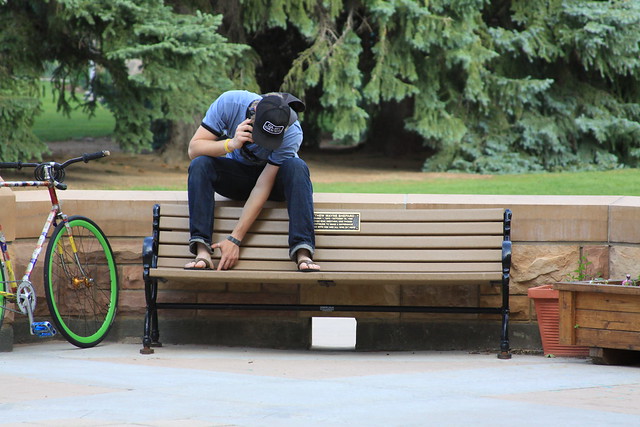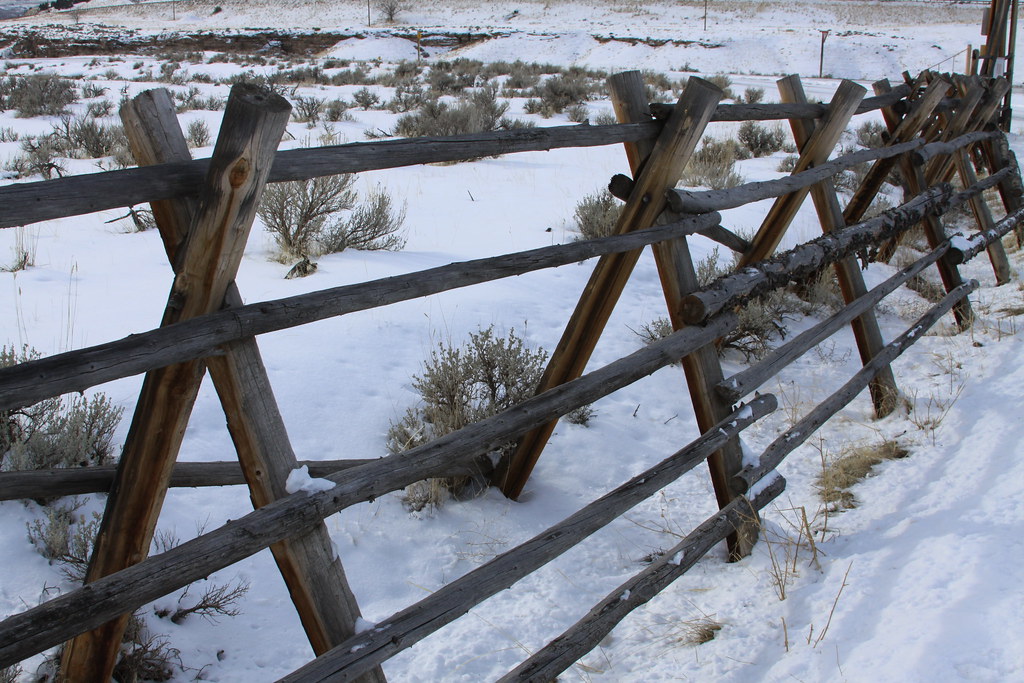The problem with visualizing the UW campus from most promo photos is that they don't show what it looks like for most of the school year-- that is, covered in snow. Up on the top of Laramie's sub-arctic plain, the snow comes early and lingers well past its time. As such, most students walk through Prexy's Pasture on the way to their classes when the ground is white rather than green, attended by the crunch of snow under boots rather than the smell of fresh-cut grass. The bewildering spring in Laramie usually comes rather late, and even during finals week, one can often find sunbathing undergraduates not too far from unmelted drifts in the sun-starved shadows.
But we Rocky Mountain types adapt to such conditions rather quickly; very little changes in our routines except the numbers of layers we wear on our way out the door. Most students who bike to class still do so in the winter, their knobby tires balanced perilously on the thick winter skin of ice glazed on the streets and walkways. Some of my favorite memories involve such tomfoolery as watching my husband-to-be play Frisbee with his buddy in the middle of the soccer field in the dead cold of January, and the year I married my Frisbee-toting trumpet player saw a freak snowstorm in the second week of June, which knocked down power lines and trees all over Laramie.
One of the things I really like about the UW campus now is the inclusion of some natural elements into the landscape, which soften the edges of the concrete in the summer, but in winter they add dimension to the endless folds of snow. As such, these boulders, trees and natural grasses make the most of Laramie's most populated season-- winter. I hope you enjoy the view!
The best view of the Student Union I could get, with a lot of that landscaping in the foreground.
North of Prexy's Pasture, looking back towards the Agriculture building and the College of Education (both obscured.)
Although I'd never want to try and ride a street bicycle on snow pack, it's not all that unusual in Laramie. Many students continue to bike through campus even in winter, even though it's impossible to keep the streets and walkways clear of ice and pack. My preferred transport was a mountain bike with very wide, knobby tires.
Some of that natural landscaping I was talking about. This is in front of the Cheney Center.
Oh, that cold, cold wind ripping off the top of the Classroom building that everyone knows so well! You get a sort of natural wind tunnel between the science buildings here sometimes.
This was one happy mutt, but his owner's fingers got a little cold after their game of fetch.
Calling all Theater companies and performers!
Open Call to Theater companies, performers, researchers:
I would like to hear other voices besides my own on this blog. If you'd like to write about your TLP experiences here, e-mail them to me and I'll put them up.
Topics can include dramaturgy to staging to personal responses to the play. Anything goes!
I would like to hear other voices besides my own on this blog. If you'd like to write about your TLP experiences here, e-mail them to me and I'll put them up.
Topics can include dramaturgy to staging to personal responses to the play. Anything goes!
Showing posts with label University of Wyoming. Show all posts
Showing posts with label University of Wyoming. Show all posts
Friday, April 1, 2011
Laramie In Picures: UW by Snowlight
Labels:
In Pictures,
University of Wyoming
Monday, November 22, 2010
UW's Web archive collection for Matthew Shepard
The University of Wyoming has collected a web archive of information relating to the murder of Matt Shepard and the political aftermath through the Internet Archive. The information is collected and stored via archive-it.org.
You can access their link pool here and check out what they've amassed. It ranges from LGBT activism to WBC home movies. If you're more interested in the social issues surrounding Shepard, it's a good resource.
You can access their link pool here and check out what they've amassed. It ranges from LGBT activism to WBC home movies. If you're more interested in the social issues surrounding Shepard, it's a good resource.
Labels:
links,
Matt Shepard,
scholarship,
University of Wyoming
Tuesday, November 2, 2010
The bench: Matthew Shepard's memorial and its landscape

In The Laramie Project: 10 Years Later, we learned about the Shepard memorial bench on the University of Wyoming campus, which is parked at the front of the Arts and Sciences building. (That's A&S there at the right.) In addition to holding the university's main concert hall venue, A&S is also home to the Political Science department (Matt's university home) and a lot of administration.
A&S holds a privileged location on campus, too: of all the enormous buildings which ring Prexy's Pasture, the functional center of the university, A&S occupies the entire western end, and the pasture in front of it sometimes feels like a grassy mall leading up to its front steps. (The bench is basically right behind that maroon van.)
So, without any further ado, here's the bench, with a closeup of the plaque:
It really is a sweet gesture, I think. It gives Matt an important place on campus to permanently commemorate his life, and it's both right in front of the A&S college and in a high traffic area when the A&S auditorium is being used. I especially like the positive message of the plaque. It commemorates Matt, not as a victim, but one who made a positive impact. After so much bad press after his murder, I think reminding the campus that Matt was a person, and one who has made a positive difference on everyone there is important. And, doing it on a piece of furniture means that people will actually interact with the memorial is a great way to set the right tone. This isn't a cumbersome monolith that forces an ambivalent memory upon a campus still covering its scars. Rather, it invites remembrance to those who stop to enjoy its presence.
So, yes, I rather like the placement and wording of the Shepard memorial, but if someone took a brisk walk around camps and even around town, she would realize that Shepard's commemoration is hardly unique. For instance:
Here we have an identical bench dedicated to former UW president Phil Dubois and donated by the Trustees. It's located a little farther up Prexy's pasture, on the side nearest to A&S.
This one is dedicated to former president Dubois' mother (complete with crow droppings from the flock of crows roosting on A&S):
This one was paid for by the Dubois family, as she passed away in 1999. The former Mrs. Dubois has her bench only about seventy-five feet from the plaza in front of A&S, sort of between A&S and Merica Hall just to the south.
There are lots of these benches around campus, and I'm willing to bet at least a dozen of them have memorial plaques, to everyone from beloved former professors to admins. (I think one I saw was for a donor, but I have no idea, really.) So, at this point I bet you're thinking, "Wow, the Shepard memorial bench isn't unique at all!" I'm afraid so-- in fact, these benches are not just a campus phenomenon. Here's one dedicated to Cal Rerucha, the former DA who prosecuted both McKinney and Henderson in 1999-2000:
You can tell from the picture that these are not the same kind of benches; I think they're part of a city rather than a university project. These benches, which sit on the north (Ivinson Avenue) side of the county courthouse, are not really reserved as memorial markers, judging by the presence of a bench with a plaque for Wal-Mart stores (I think it's the one just past the upper left-hand corner of this photo. Rather, they're more like tiny billboards. I think that's the point of the Reruchas' plaque on this one: it simply names himself and his wife as "attorneys at law." What better place for a lawyer to hang out his shingle than in front of the courthouse, eh?
So, I guess there are two different ways to look at Matt's bench in the context of the surrounding environment. The negative one might complain that Matt's memorial isn't really all that special, and the only way they managed to get on campus was to sneak it in under a campus beautification project. It's almost like saying, "Okay, we'll actually let you mark the campus with his memory, but his memorial can't draw attention to itself..." Honestly, I suppose that's how I felt about it when I first wandered about the campus that afternoon, but I think that there's a second, positive way to think about the bench.
What helped me change my mind? On the way back to my car one afternoon, I was walking back towards Prexy's in the direction of my car when I saw this fellow chatting on the phone:
Seeing this student casually tracing his hands down the bench as he talked on his phone made me stop to think: what are the chances that this kid will look down and see the plaque? Maybe he will, but he might not, either. Even though this student's act of remembrance isn't what most people think when they try to picture commemoration, this interaction with Shepard's memory on his own terms shows how the bench incorporates Matthew's memory into the very fabric of UW's landscape. This is unlike a normal memorial marker, like the one for the Challenger explosion on the west side of campus. When I lived on campus, the Challenger astronauts' stone and bronze marker only really got any attention when someone used it as a hole for Frisbee golf. Then some of us felt a little queasy about the idea of slapping the Challenger astronauts in the face with a golf disc, and eventually we moved the hole. After that, none of us really even noticed it anymore.
In contrast to the Challenger memorial, Matt's bench gets a lot of daily interaction because it's designed for interactive experience. As students look for a quiet spot to read and bask in the sun, they seek it out. And, since it's part of a larger network of memorial benches to other beloved people, the bench presents who he really was to the campus: someone who was a part of the UW community and whose life has indelibly left its mark on us all.
One evening after photographing Old Main, I stopped to have a seat on the memorial bench myself. As I sat in the lengthening shadows of A&S, I could gaze upward to its highest floors dressed in sandstone, or the huge, stately pines which dominate the green spaces on the north side. To my left was Prexy's Pasture, with its diamond pattern of walkways leading to the family/unity statue in the center, and the flagpoles for the university, state, and nation beyond. It's a good place to sit and ponder, I decided, and as students do that, they meet with a little piece of Shepard's life. And every time we do, we remember a little piece of Matt.
Labels:
commemoration,
landscape,
Matt Shepard,
University of Wyoming
Friday, September 24, 2010
Laramie in Pictures: Campus Scenes
The campus has changed a lot since I was a naive little undergraduate here. For one, we now have a "Cheney International Center" (no freaking kidding) and a new Anthropology building. I was saddened to find the old Honors house razed to the ground and an OIT center plunked in its place. (It was just as well, to be honest.) Somebody finally got wise and also ripped down a good chunk of Coe Library and turned it into a usable library space complete with coffee shop and up-to-date computer lab. And, most noticeably, they have put what must have been an incredible chunk of money into campus beautification, fuzzing out the hard edges of the concrete public spaces with small gardens full of boulders and birch trees, landscaped with native flowers. I always thought this was a beautiful campus, but now it might be one of the most charming college campuses in the western US. I'm serious.
But the important things-- to me at least-- haven't changed much at all. The sandstone walls of the buildings still glow like gold when the sun is at the right angle, Prexy's pasture is still the same, and the squirrels still cuss and throw things at you when you walk between Merica Hall and Old Main. The Fine Arts building still looks like it's built out of cardboard graham crackers, sagging a little around the edges. Although I didn't see him out there this summer, I was reassured that Dr. Shive in the Honors Program still roams the green spaces, plunking down birdies on the ad-hoc Frisbee golf course with deadly accuracy despite his advancing years.
So, here are a few pictures of some of the places that most define the Laramie campus: Old Main, the original campus building from the territorial days, Arts and Sciences, and even some of that fancy new landscaping that blurs the distinction between public and natural space in ways that I think I rather like. Enjoy!
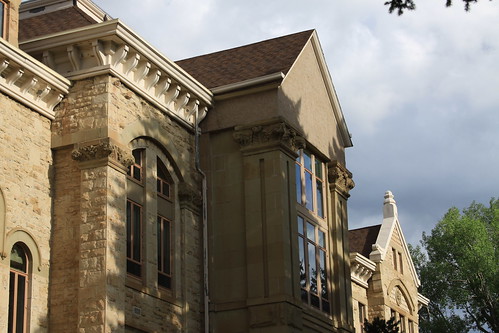
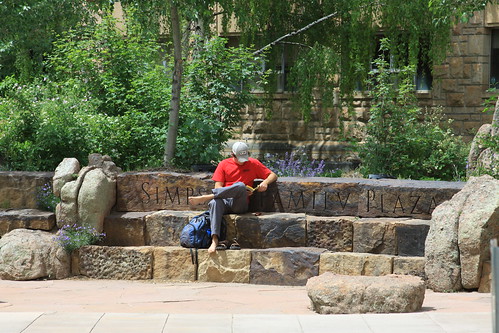



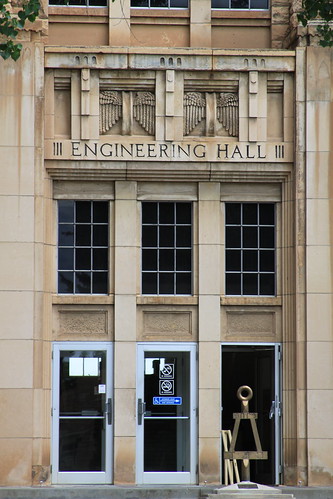
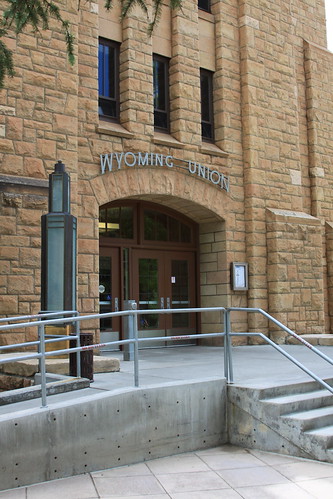


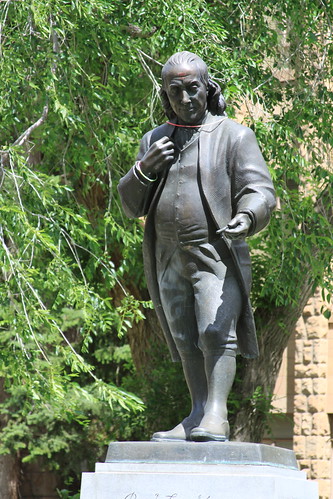
But the important things-- to me at least-- haven't changed much at all. The sandstone walls of the buildings still glow like gold when the sun is at the right angle, Prexy's pasture is still the same, and the squirrels still cuss and throw things at you when you walk between Merica Hall and Old Main. The Fine Arts building still looks like it's built out of cardboard graham crackers, sagging a little around the edges. Although I didn't see him out there this summer, I was reassured that Dr. Shive in the Honors Program still roams the green spaces, plunking down birdies on the ad-hoc Frisbee golf course with deadly accuracy despite his advancing years.
So, here are a few pictures of some of the places that most define the Laramie campus: Old Main, the original campus building from the territorial days, Arts and Sciences, and even some of that fancy new landscaping that blurs the distinction between public and natural space in ways that I think I rather like. Enjoy!










Labels:
In Pictures,
University of Wyoming
Saturday, September 11, 2010
Shameless plug for RBU...
I have been known, in my spare time, to write a little poetry-- whether or not it's good poetry I'll leave up to the experts, but I do write poetry nonetheless.
If you're interested in seeing what I can do with two idle hands and a wandering imagination, I have a poem right now posted on Real Bloggers United: The Blog. It's a fun little piece about-- you guessed it-- Laramie. Sort of. It's more about a picture I saw once in a UW yearbook.
Actually, this month's postings, thus far, promise to be quite interesting. Glen of Glen's Life has a great post up about camping misadventures, and with a "blogger's choice" topic for the month, the postings should be quite entertaining. Check it out!
If you're interested in seeing what I can do with two idle hands and a wandering imagination, I have a poem right now posted on Real Bloggers United: The Blog. It's a fun little piece about-- you guessed it-- Laramie. Sort of. It's more about a picture I saw once in a UW yearbook.
Actually, this month's postings, thus far, promise to be quite interesting. Glen of Glen's Life has a great post up about camping misadventures, and with a "blogger's choice" topic for the month, the postings should be quite entertaining. Check it out!
Labels:
creative writing,
RBU,
University of Wyoming
Friday, July 16, 2010
Free Stuff! Yay!
Okay, so an important goal for this blog is to make it useful for others who are interested in The Laramie Project or Laramie, Wyoming. One way I've tried to do that in the past has been to put together a running bibliography of useful literature on the plays. So far, it has (rightly) been the most popular page on this blog, which makes me quite happy.
The next thing I wanted to do was provide visual materials. It's hard to find pics of Laramie or relating to TLP that are actually, you know, usable for free. It's mostly protected under full copyright. There's not a lot on Flickr for Laramie that's under Creative Commons, so I took a bunch of pics while I was in Laramie this summer, and I'm currently cleaning them up and posting them. These range from pics of the campus and the plains to a surprisingly close reproduction of the Vintage cover of The Laramie Project (which, if you've ever wondered, is the exit from I-80 onto Grand Avenue).
You can access the ones I have up so far (and the list will be growing) at the links gadget on the right. There's one page right now for pictures of the town of Laramie, one for the campus area, and one for landscapes. These pages will be growing over time, so it wouldn't hurt to check back in a month or so to see what's new.
These are free for any non-commercial or editorial use, and you're free to print them without specific permission in any materials, as long as you're not specifically selling them. (And if you do want to use them for sellable stuff, just drop me a note.)
They're protected under a Attribution-NonCommercial-ShareAlike Creative Commons copyright, so that gives you a lot of flexibility!
To give you a sample, here's one of my more interesting photos-- a picture of the Matthew Shepard memorial bench being put to good use. Enjoy!
The next thing I wanted to do was provide visual materials. It's hard to find pics of Laramie or relating to TLP that are actually, you know, usable for free. It's mostly protected under full copyright. There's not a lot on Flickr for Laramie that's under Creative Commons, so I took a bunch of pics while I was in Laramie this summer, and I'm currently cleaning them up and posting them. These range from pics of the campus and the plains to a surprisingly close reproduction of the Vintage cover of The Laramie Project (which, if you've ever wondered, is the exit from I-80 onto Grand Avenue).
You can access the ones I have up so far (and the list will be growing) at the links gadget on the right. There's one page right now for pictures of the town of Laramie, one for the campus area, and one for landscapes. These pages will be growing over time, so it wouldn't hurt to check back in a month or so to see what's new.
These are free for any non-commercial or editorial use, and you're free to print them without specific permission in any materials, as long as you're not specifically selling them. (And if you do want to use them for sellable stuff, just drop me a note.)
They're protected under a Attribution-NonCommercial-ShareAlike Creative Commons copyright, so that gives you a lot of flexibility!
To give you a sample, here's one of my more interesting photos-- a picture of the Matthew Shepard memorial bench being put to good use. Enjoy!
Labels:
In Pictures,
Laramie,
links,
University of Wyoming,
Wyoming
Monday, May 10, 2010
TT writes for Newsweek: "Has Anything Changed?"
Tectonic wrote a short but illuminating online piece for Newsweek talking about the Laramie community-- it's called, naturally, "Has Anything Changed?" It's also basically the sentiment of the prologue they read before the performance of The Laramie Project: 10 Years Later and includes a certain amount of the information they used in the final version of the play.
I found it an interesting view into Tectonic's attitude as they prepared to enter into Laramie one more time, and it was good to see how much they tried to keep an open mind of what "change" might look like in a community. But it also outlined some things that I'd like to write about over the next few weeks. Check it out!
URL: http://www.newsweek.com/id/163027
I found it an interesting view into Tectonic's attitude as they prepared to enter into Laramie one more time, and it was good to see how much they tried to keep an open mind of what "change" might look like in a community. But it also outlined some things that I'd like to write about over the next few weeks. Check it out!
URL: http://www.newsweek.com/id/163027
Labels:
10 Years Later,
activism,
links,
Tectonic Theater,
University of Wyoming
Friday, May 7, 2010
Scatter Plots, cont.: Who's speaking?
So, I've spent the last few posts looking at how Tectonic fudges around a few data points from our survey of Laramie, WY in order to make the pattern more uniform. For a long time, this really bothered me. Could that have been a necessary evil, however? Let's take a look now at how the background politics of who's speaking actually might necessitate covering up some background information for the good of the play-- and a fair representation of the community.
These two voices speak to more than the experience of just a semi-retired actor and a university admin specialist. They're the voices of those who can speak to both their own personal experiences as well as the experience of gay men in the Laramie community at large. And within that community, they each have a unique story to tell about their life within the community as a whole. That's how I'd like to finish out with this discussion this week-- looking at how these voices speak for more than just one side of Laramie, and with more clarity if we let them be a little less specific...
And it was... it was just... I'm fifty-two years old and I'm gay. I have lived here for many years and I've seen a lot.
-- Harry Woods, in TLP (2000): 63
When I came here I knew it was going to be hard as a gay man... but I kept telling myself: People should live where they want to live... I mean, imagine if more gay people stayed in small towns. But it's easier said than done of course.
-- Jonas Slonaker, in TLP (2000): 22-23
These two voices speak to more than the experience of just a semi-retired actor and a university admin specialist. They're the voices of those who can speak to both their own personal experiences as well as the experience of gay men in the Laramie community at large. And within that community, they each have a unique story to tell about their life within the community as a whole. That's how I'd like to finish out with this discussion this week-- looking at how these voices speak for more than just one side of Laramie, and with more clarity if we let them be a little less specific...
Sunday, May 2, 2010
Scatter Plots, cont: Fudging the Data
Okay, so in my previous post I basically pulled the rug out from under a few (vaguely) identified people in the original Laramie Project in order to show one thing: this play represents the university side of the social divide a lot more heavily than it does any other. I guess that the next question would be this: does this matter?
In one important way, it does. And in one important way, it doesn't. That's what I'd like to go through with you today. Before we go on, though, I'd like to beg your attention to one thing: you can't read this post alone because you'll get a distorted view of my opinion. Definitely read the next two posts too, so you can get the full picture.
Just past First Street in Laramie there is a huge railway switching station that divides the town in two; it's enormous, with the parallel tracks stacked up for at least the width of a city block. Alison Mears and Marge Murray talk about their own connection to the rail yard in detail. My own connection to the yard is a little different. I used to spend a lot of time out there when I was a freshman; there's a catwalk that goes over the tracks right next to Coal Creek Coffee Company, and I used to stand on that bridge to watch the trains go by so I could clear my head. Those tracks literally divide the town into two stations, the well-heeled university town and the proverbial "wrong side" of the tracks, West Laramie.
West Laramie used to be the housing block for railroad workers, mechanics and day-laborers, and the houses can be small, gentrified and shabby. In reality, the distinction is more metaphorical than anything; some of the apartments that the university and Tech students rent on the east side get pretty run-down, too (Laramie has a bit of a college housing problem), but that's not the identity stuck on the other side of town. For me, the tracks delineate that divide between "town and gown" in Laramie fairly effectively: the university represents wealth, intellectualism and (to the town people) class snobbery and intellectual elitism, and West Laramie represents poverty, conservatism and (to the university) social disorder, intolerance and ignorance.
So, how bad is that divide between "town and gown" in Laramie? Well, it's pretty distinct, and the angst on both sides can be bitter. To be straight with you, this distinction is one I've struggled with for most of my career. The phrase "oil field trash" might not mean much to you, but it does to me. My father was a roustabout for an oil company most of my life. When I got to college, I found out that my lived experience as the daughter of said oil company field hand didn't fit in with most of my white-collar, middle-class classmates and teachers, and I burned with anger every time I heard someone at the college talk about the laboring classes as "those people" or "ignorant" or "trash." In reality, my father reads more, and reads more closely, than most of the grad students I've met-- and he's also a better poet. When a beloved and revered professor of mine referred apologetically to my family as "white trash," I had to fight not to burst into tears of rage. This divide hits a little too close to home for me.
It's also a divide that has split my family. When I lived in Laramie, both my siblings at some point were living in West Laramie while I lived on the campus, as my brother dropped out of college for personal reasons and my sister was working as a foreman for a traffic control subcontractor. Our daily lives looked nothing alike, and since I was fulfilling my parents' aspirations for a college grad in the family and they weren't, my parents unfairly preferred me to them. And, since they felt the bite of that class antagonism that they perceived coming from the campus, they often saw me as part of the same society and bit back. My sister was convinced for a while that I judged her because she worked construction and her job was "dirty." My brother constantly got into verbal sparring contests with me to prove that he was smarter than I was (although I've never questioned that). Although it took several years of hard work on both sides, this rift has healed quite a bit. In addition, my sister now holds a degree of her own and my brother is back in college; knowing how hard they've both fought to get there, I'm super-proud of them both.

So, that's how I've experienced this divide between "town" and "gown." This same kind of tension between myself and my own siblings eventually turned into part of the problem after the Shepard beating: Matt was a college kid from a wealthy family, the "gown" side of the debate if you will. Henderson and McKinney were from the other side of the tracks in the west, part of the "town." The distinction couldn't have been scripted any better to create class anxiety. And, since I don't feel like Tectonic was able to break in to the "town" side very effectively, it might actually exacerbate the situation a little bit. I'm worried that the "town" feels like that the "gown" is judging them for their faults, something that I've outlined a little already in "Failure to Engage."
These non-identified people-- Lockwood, Woods, and Slonaker-- speak at crucial moments in the play, and to important changes in the community. Lockwood realizes through the media slam that the community's ideals breed violence (46); Woods sees his dream of support for the gay community come true (63-64). And Slonaker? Well... he's Slonaker. He's our voice of reason almost, the universal gay male experience who can stand back and look at the progress of the community critically, exploding its myths.
Whether or not you see these characters as "inside" or "outside" the university can make a lot of difference. For example, here's a little trick I like to play on my students: I have them put together a character sketch of Harry Woods based upon the information given in their edition of the play in preparation for acting his part. I have them map out his position in the community and his acceptance within it, his career, life experience-- some students even go so far as to speculate where he got that broken leg and who they'd recruit to play his part. The results are pretty stunning. Every single group except for two (both extremely skeptical) placed him on the extreme edge of the Laramie society with no community where he finds acceptance, and he's in the laboring class, and that broken leg is often a work injury. (One group even put him in a plaid shirt and jeans, which of course made me giggle.) When I tell them that he's an actor and staff of the Fine Arts department, the characterization completely changes, mostly because they realize that he has a community in which he feels accepted and can find fulfillment. Then, I'm afraid, their characterizations of Harry become a tad less sympathetic.
So, naturally, my students come up with a completely different character sketch of that dour-faced fellow I'd see in the Fine Arts building almost every week before my Wind Ensemble rehearsal. Actors who play Harry run into the same thing, apparently. I had the privilege to chat with the actor who played both Jed Schultz and Harry Woods from the 2006 production of TLP after the show, and I asked him how he constructed a character for Harry. (It wasn't too far afield of my students' analysis). Then I told him who Harry was, and he was really surprised; when I asked him if he would have portrayed Harry differently if he'd known his occupation, this actor said, "Heck yeah. That really changes things." He then told me how he believed that knowledge altered Harry's placement in the community and whom he speaks for.
So is this a problem, I ask again? I've already outlined how it is a problem in the way it exacerbates the class antagonism in Laramie. If you're a Laramie resident and you know that these enlightened and more judgmental opinions are coming from the university (like so much of the rest of the play), this play really could feel like just another attack by the intellectuals on the mores of the society at large. I can only imagine that people like my siblings, who know who Harry Woods is (and didn't like him) would have listened to Harry give his lines back then and reject what he has to say because of whom they think he represents. In their minds, Harry doesn't represent them. He represents others. And covering up that fact in the play to them would just feel like deception.
So, did Tectonic realize this problem? Belber says they did, and that's part of why (I think) these people labeled as "residents" aren't identified by occupation like most of the other interviewees are. I see a need on their part to have more of a universal voice for certain opinions-- like Jeff Lockwood's realization that "we really do grow children like that here" and Harry Wood's relief and gratitude at seeing the cold war between straight and gay thaw a little at the homecoming parade. They really needed those opinions to come from the community as a whole and not just from university professors and actors. So that's what they became-- Laramie residents. They flattened out the specificity of these people to remove their "gown" association on the "town and gown" conflict to make them, as Laramie residents, speak for the whole community and not just a part. They effectively hide it.
So there's a really good reason to want to provide that kind of class anonymity for some voices, and that's what I'd like to look at in my final post on this topic.
PHOTO CREDITS:
1) The footbridge across the tracks, Laramie WY, courtesy elmada's Flickr photostream:
2) Looking north from the footbridge, courtesy elmada's Flickr photostream (same license as above.)
3) Coal Creek Coffee Company in Laramie, WY, courtesy elmada's Flickr photostream (same license as above.)
4) The Laramie rail yard, courtesy of ChiaLynn's Flickr Photostream:
In one important way, it does. And in one important way, it doesn't. That's what I'd like to go through with you today. Before we go on, though, I'd like to beg your attention to one thing: you can't read this post alone because you'll get a distorted view of my opinion. Definitely read the next two posts too, so you can get the full picture.
Now that I'll tell ya, here in Laramie there is a difference and there always has been. What it is is a class distinction. It's about the well-educated and the ones that are not. And the educated don't understand why the ones that are not don't get educated.
--Marge Murray in TLP (2000): 16
Henderson and Pasley live in a rural, windswept trailer park amid weeds, engine parts, fishing tackle, and barking dogs. A neighbor, John Gillham, 21, said the couple generally kept to themselves.
About a thousand people attended a candlelight vigil Sunday night near the University of Wyoming campus to show their support for Shepard.-- AP Online report, Oct. 12, 1998
Just past First Street in Laramie there is a huge railway switching station that divides the town in two; it's enormous, with the parallel tracks stacked up for at least the width of a city block. Alison Mears and Marge Murray talk about their own connection to the rail yard in detail. My own connection to the yard is a little different. I used to spend a lot of time out there when I was a freshman; there's a catwalk that goes over the tracks right next to Coal Creek Coffee Company, and I used to stand on that bridge to watch the trains go by so I could clear my head. Those tracks literally divide the town into two stations, the well-heeled university town and the proverbial "wrong side" of the tracks, West Laramie.
West Laramie used to be the housing block for railroad workers, mechanics and day-laborers, and the houses can be small, gentrified and shabby. In reality, the distinction is more metaphorical than anything; some of the apartments that the university and Tech students rent on the east side get pretty run-down, too (Laramie has a bit of a college housing problem), but that's not the identity stuck on the other side of town. For me, the tracks delineate that divide between "town and gown" in Laramie fairly effectively: the university represents wealth, intellectualism and (to the town people) class snobbery and intellectual elitism, and West Laramie represents poverty, conservatism and (to the university) social disorder, intolerance and ignorance.
So, how bad is that divide between "town and gown" in Laramie? Well, it's pretty distinct, and the angst on both sides can be bitter. To be straight with you, this distinction is one I've struggled with for most of my career. The phrase "oil field trash" might not mean much to you, but it does to me. My father was a roustabout for an oil company most of my life. When I got to college, I found out that my lived experience as the daughter of said oil company field hand didn't fit in with most of my white-collar, middle-class classmates and teachers, and I burned with anger every time I heard someone at the college talk about the laboring classes as "those people" or "ignorant" or "trash." In reality, my father reads more, and reads more closely, than most of the grad students I've met-- and he's also a better poet. When a beloved and revered professor of mine referred apologetically to my family as "white trash," I had to fight not to burst into tears of rage. This divide hits a little too close to home for me.
It's also a divide that has split my family. When I lived in Laramie, both my siblings at some point were living in West Laramie while I lived on the campus, as my brother dropped out of college for personal reasons and my sister was working as a foreman for a traffic control subcontractor. Our daily lives looked nothing alike, and since I was fulfilling my parents' aspirations for a college grad in the family and they weren't, my parents unfairly preferred me to them. And, since they felt the bite of that class antagonism that they perceived coming from the campus, they often saw me as part of the same society and bit back. My sister was convinced for a while that I judged her because she worked construction and her job was "dirty." My brother constantly got into verbal sparring contests with me to prove that he was smarter than I was (although I've never questioned that). Although it took several years of hard work on both sides, this rift has healed quite a bit. In addition, my sister now holds a degree of her own and my brother is back in college; knowing how hard they've both fought to get there, I'm super-proud of them both.

So, that's how I've experienced this divide between "town" and "gown." This same kind of tension between myself and my own siblings eventually turned into part of the problem after the Shepard beating: Matt was a college kid from a wealthy family, the "gown" side of the debate if you will. Henderson and McKinney were from the other side of the tracks in the west, part of the "town." The distinction couldn't have been scripted any better to create class anxiety. And, since I don't feel like Tectonic was able to break in to the "town" side very effectively, it might actually exacerbate the situation a little bit. I'm worried that the "town" feels like that the "gown" is judging them for their faults, something that I've outlined a little already in "Failure to Engage."
These non-identified people-- Lockwood, Woods, and Slonaker-- speak at crucial moments in the play, and to important changes in the community. Lockwood realizes through the media slam that the community's ideals breed violence (46); Woods sees his dream of support for the gay community come true (63-64). And Slonaker? Well... he's Slonaker. He's our voice of reason almost, the universal gay male experience who can stand back and look at the progress of the community critically, exploding its myths.
Whether or not you see these characters as "inside" or "outside" the university can make a lot of difference. For example, here's a little trick I like to play on my students: I have them put together a character sketch of Harry Woods based upon the information given in their edition of the play in preparation for acting his part. I have them map out his position in the community and his acceptance within it, his career, life experience-- some students even go so far as to speculate where he got that broken leg and who they'd recruit to play his part. The results are pretty stunning. Every single group except for two (both extremely skeptical) placed him on the extreme edge of the Laramie society with no community where he finds acceptance, and he's in the laboring class, and that broken leg is often a work injury. (One group even put him in a plaid shirt and jeans, which of course made me giggle.) When I tell them that he's an actor and staff of the Fine Arts department, the characterization completely changes, mostly because they realize that he has a community in which he feels accepted and can find fulfillment. Then, I'm afraid, their characterizations of Harry become a tad less sympathetic.
So, naturally, my students come up with a completely different character sketch of that dour-faced fellow I'd see in the Fine Arts building almost every week before my Wind Ensemble rehearsal. Actors who play Harry run into the same thing, apparently. I had the privilege to chat with the actor who played both Jed Schultz and Harry Woods from the 2006 production of TLP after the show, and I asked him how he constructed a character for Harry. (It wasn't too far afield of my students' analysis). Then I told him who Harry was, and he was really surprised; when I asked him if he would have portrayed Harry differently if he'd known his occupation, this actor said, "Heck yeah. That really changes things." He then told me how he believed that knowledge altered Harry's placement in the community and whom he speaks for.
So is this a problem, I ask again? I've already outlined how it is a problem in the way it exacerbates the class antagonism in Laramie. If you're a Laramie resident and you know that these enlightened and more judgmental opinions are coming from the university (like so much of the rest of the play), this play really could feel like just another attack by the intellectuals on the mores of the society at large. I can only imagine that people like my siblings, who know who Harry Woods is (and didn't like him) would have listened to Harry give his lines back then and reject what he has to say because of whom they think he represents. In their minds, Harry doesn't represent them. He represents others. And covering up that fact in the play to them would just feel like deception.
So, did Tectonic realize this problem? Belber says they did, and that's part of why (I think) these people labeled as "residents" aren't identified by occupation like most of the other interviewees are. I see a need on their part to have more of a universal voice for certain opinions-- like Jeff Lockwood's realization that "we really do grow children like that here" and Harry Wood's relief and gratitude at seeing the cold war between straight and gay thaw a little at the homecoming parade. They really needed those opinions to come from the community as a whole and not just from university professors and actors. So that's what they became-- Laramie residents. They flattened out the specificity of these people to remove their "gown" association on the "town and gown" conflict to make them, as Laramie residents, speak for the whole community and not just a part. They effectively hide it.
So there's a really good reason to want to provide that kind of class anonymity for some voices, and that's what I'd like to look at in my final post on this topic.
PHOTO CREDITS:
1) The footbridge across the tracks, Laramie WY, courtesy elmada's Flickr photostream:
2) Looking north from the footbridge, courtesy elmada's Flickr photostream (same license as above.)
3) Coal Creek Coffee Company in Laramie, WY, courtesy elmada's Flickr photostream (same license as above.)
4) The Laramie rail yard, courtesy of ChiaLynn's Flickr Photostream:
Sunday, April 25, 2010
Scatter Plots: Of Angst and Ethnography
In the beginning of The Laramie Project, one of the company members, Amanda Gronich, expresses a little bit of dismay at the task in front of them:"I've never done anything like this in my life. How do you get people to talk to you? What do you ask?" (10). She's got a valid point. I suppose that most people think it's a simple matter of just walking up to somebody and asking a few questions, but I'm getting a better idea of how hard doing that can actually be. The kind of information you get from an interview depends heavily upon the kind of relationship that the interviewer and interviewee have built between each other, and most subjects are reluctant to volunteer intimate details or make themselves vulnerable to a person whom they don't trust. In a sense, they were working with the wrong model; they kept talking about themselves as acting like journalists, but some of them (Belber, at the very least) unconsciously start acting more like ethnographers. Belber, for instance, is painfully aware of his relationship to the people he interviews. That's part of what pleases me about Tectonic Theater: the kinds of conversations they managed to have with some of these people hints at the creation of a close and trusting relationship between themselves and their interviewees, and they managed to do that in just six visits.
But how do you get people to talk to you? I have a very good friend here at the university who is a graduate student in RWL. Her main emphasis is composition and pedagogy with an ethnographic focus, and she's very interested in academically studying how students from her own cultural background learn how to negotiate in a college environment. I watched her comb our campus and other colleges in the area trying to find undergraduates who wanted to be interviewed, but after months of fruitless effort, unanswered phone calls and IRB limitations, she had to scrap her original topic for something else. Now she's drawing her study subjects from among friends and colleagues who fit within the same demographic.
My friend "Colleen" has been heavily trained in the techniques, ethics and processes of ethnographic inquiry, and even she couldn't break in to the undergraduates' lives enough to convince them to speak to her. She's even an "insider"; she comes from the same background as these students. So she had to back up a little and work with people she could count on and who were already comfortable talking with her. She needed to find people whom she could trust and could also trust her, and that took a prior relationship.
So, what does this have to do with The Laramie Project? Quite a bit, actually. "Colleen" discovered how hard it was to break into the lives of a community of people (in her case, college undergraduates) without prior connections; I anticipate that Tectonic had the same problems when they approached a hurting and traumatized community very much aware of how outsiders saw them.
But how do you get people to talk to you? I have a very good friend here at the university who is a graduate student in RWL. Her main emphasis is composition and pedagogy with an ethnographic focus, and she's very interested in academically studying how students from her own cultural background learn how to negotiate in a college environment. I watched her comb our campus and other colleges in the area trying to find undergraduates who wanted to be interviewed, but after months of fruitless effort, unanswered phone calls and IRB limitations, she had to scrap her original topic for something else. Now she's drawing her study subjects from among friends and colleagues who fit within the same demographic.
My friend "Colleen" has been heavily trained in the techniques, ethics and processes of ethnographic inquiry, and even she couldn't break in to the undergraduates' lives enough to convince them to speak to her. She's even an "insider"; she comes from the same background as these students. So she had to back up a little and work with people she could count on and who were already comfortable talking with her. She needed to find people whom she could trust and could also trust her, and that took a prior relationship.
So, what does this have to do with The Laramie Project? Quite a bit, actually. "Colleen" discovered how hard it was to break into the lives of a community of people (in her case, college undergraduates) without prior connections; I anticipate that Tectonic had the same problems when they approached a hurting and traumatized community very much aware of how outsiders saw them.
Sunday, April 18, 2010
Scatter Plots
One of my students particularly enamored with The Laramie Project and endowed with a more mathematical imagination once described TLP as a "scatter plot" of Laramie, a broad and random cross-section of the entire community that gives a good idea of the total population. That's one of the real beauties of TLP, honestly: we hear from ranchers, professors, police officers, Mormon home teachers, and college students, just to name a few. The way these voices all come together to show their different experiences of the exact same event creates an incredible picture of a "collected memory," to use James E. Young's term. All these voices are focused on the m emory of the same, life-changing moment; but very few of them share the same experience.
And yet, when I think back to this student's comment, I'm a little conflicted. I completely agree with the metaphor he picked-- the play is incredibly rich in its portrayals of the Laramie community. The thing that bothers me a little is that I know that the scatter isn't entirely random. It's a scatter plot, sure, but where did they take the points from? If you understand a little bit about the background and connections between some of the key players in their drama, the plot looks a lot less random than perhaps Tectonic tries to make us believe. That's the labyrinth I'd like to plunge us into over the next few weeks.
But before I get started, please, please understand-- I don't intend to "out" anybody who doesn't want to be found (for instance, I'm not telling you who The Baptist Minister is). After all, I'm coveting my own anonymity at the moment, so I insist on maintaining that for others. I'm just going to give you the information that any regular person walking around the UW campus can find out-- no dirty laundry. I'm not going to tell you the name of anybody who asked for anonymity, and I'm not going to give out anything that isn't revealed elsewhere or isn't common knowledge.
Okay, so here's some information about a few interviewees that aren't volunteered by Tectonic in The Laramie Project:
And yet, when I think back to this student's comment, I'm a little conflicted. I completely agree with the metaphor he picked-- the play is incredibly rich in its portrayals of the Laramie community. The thing that bothers me a little is that I know that the scatter isn't entirely random. It's a scatter plot, sure, but where did they take the points from? If you understand a little bit about the background and connections between some of the key players in their drama, the plot looks a lot less random than perhaps Tectonic tries to make us believe. That's the labyrinth I'd like to plunge us into over the next few weeks.
But before I get started, please, please understand-- I don't intend to "out" anybody who doesn't want to be found (for instance, I'm not telling you who The Baptist Minister is). After all, I'm coveting my own anonymity at the moment, so I insist on maintaining that for others. I'm just going to give you the information that any regular person walking around the UW campus can find out-- no dirty laundry. I'm not going to tell you the name of anybody who asked for anonymity, and I'm not going to give out anything that isn't revealed elsewhere or isn't common knowledge.
Okay, so here's some information about a few interviewees that aren't volunteered by Tectonic in The Laramie Project:
Monday, February 1, 2010
Fear, Loathing and "The Laramie Project": the 2000 Production
Now that I have explained my relationship to the Matt Shepard tragedy and the two trials, I need to explain the next phase. My story doesn't really end with the conviction of Matt's killers; it continues through my experience with The Laramie Project to the reading of Ten Years Later. A lot of my fear and loathing really comes out in relation to the play than anything else-- so I suppose that is what I'll have to explain next: my first experience riding out the shock waves of that earthquake of a play produced by Tectonic Theater.
Before the 2000 Tectonic performance in Laramie, I never really considered myself "traumatized" by what had happened after Matt's murder. It was merely a headache, one among many. After all, I never knew Matt; In comparison to other people like "Sascha," who was his friend and was still hurting two years later, what right did I have to bear those kinds of psychological wounds?
Besides, I had bigger problems: screwing up the relationship I was in; trying to deal with seeing what was left of a suicide jumper from the top of my dorm; worrying about my brother dropping out of college and getting into trouble and my sister still trying to deal with the wreckage of a messy divorce; the death of a favorite high school teacher in a car wreck; running into spiritual questions I couldn't answer. The Shepard incident and the media problems seemed to be just one minor problem of a whole host of other issues that hit much closer to home and consumed much more of my attention.
Before the 2000 Tectonic performance in Laramie, I never really considered myself "traumatized" by what had happened after Matt's murder. It was merely a headache, one among many. After all, I never knew Matt; In comparison to other people like "Sascha," who was his friend and was still hurting two years later, what right did I have to bear those kinds of psychological wounds?
Besides, I had bigger problems: screwing up the relationship I was in; trying to deal with seeing what was left of a suicide jumper from the top of my dorm; worrying about my brother dropping out of college and getting into trouble and my sister still trying to deal with the wreckage of a messy divorce; the death of a favorite high school teacher in a car wreck; running into spiritual questions I couldn't answer. The Shepard incident and the media problems seemed to be just one minor problem of a whole host of other issues that hit much closer to home and consumed much more of my attention.
Friday, January 22, 2010
Fences, cont.: Memory, Tragedy and Entropy
I can't really explain my feelings when I found out. I saw in a photo essay shortly before watching Ten Years Later that the buck fence where Matt Shepard was beaten had been torn down, and I gasped. From the picture I saw, it looks like it had been replaced with a single-rail, low, log zipper fence just to mark the boundary, something I hadn't actually seen much out west. It was a weird sensation; I had never specifically been out to the fence (I didn't want to be one of the gawkers) so I had no personal frame of reference. And yet, taking it down felt like an affront, or admitting defeat, or something-- I don't know what. All I know is that I didn't like it.
My husband and I had a long conversation about the fence that evening when we were getting ready for bed. When I told him about it, I was a little offended; it seemed like a deliberate attempt to efface Matt's memory from that area. My husband, however, disagreed. "Well, why shouldn't the landowner take down the fence?" He asked me. "It's his property."
"Well, because he's just trying to forget what happened there," I grumbled. "That's not right. There are too many people trying to just forget it."I still don't know for sure what I think, but my husband has a point. Just because the fence is gone doesn't mean that Matt's memory is lessened, and it might have honestly been necessary. Let me see if I can explain to you why...
"But when does the landowner get to move on?" He insisted. "He didn't have anything to do with this. When can he stop having people show up unannounced on his property, respectfully or otherwise? Does he ever get to stop having that crime brought to mind when he's on that property? Does that spot ever get to be something besides a memorial?" I gave him a glare. "Moving on doesn't necessarily mean forgetting," he insisted.
Labels:
buck fence,
commemoration,
Lit crit,
place,
remembrance,
trauma,
University of Wyoming,
Wyoming
Thursday, January 14, 2010
Links: Laramie Inside Out
One of the lesser known films about the Shepard incident and the LGBTQ community in Wyoming is Laramie Inside Out, a quite good documentary of Laramie, its people, and the protests that were going on during the trials. I can't say as I have ever met the producer of the film (she graduated before I got to Laramie), but Beverly Seckinger is a Laramie native and filmmaker with ties to many of the same professors as I do-- particularly the Harrises, Dr. Duncan Harris of English and Dr. Janice Harris of English/Women's studies. These two beloved members of the faculty have served as sort-of foster parents for the Honors Program students for years.
You can find out about the film and view a synopsis of it on the film website, larmieinsideout.com. If I can get up the gumption to do it (I'm still a little chicken), I might check this out from our university library and give you a review of the film later this year, when I have a little more free time. In the meantime, I'd encourage you to do the same!
You can find out about the film and view a synopsis of it on the film website, larmieinsideout.com. If I can get up the gumption to do it (I'm still a little chicken), I might check this out from our university library and give you a review of the film later this year, when I have a little more free time. In the meantime, I'd encourage you to do the same!
Labels:
GLBT,
Laramie,
links,
protests,
University of Wyoming
Friday, December 11, 2009
UW's resource page for the Matt Shepard attack
In my quest to find as many resources as possible on the Shepard killing and The Laramie Project I have discovered that the University of Wyoming never cleans out their press releases. This means that they're turning into a great online source to get the university's response to the Shepard killing.
For instance, during the media blitz they put together a news page with all the university's official releases on it to streamline media access. Here is the link to that page for some great primary source information about the university's response to Shepard's beating and murder. It includes addresses at both the candlelight vigil and the memorial held the next day and some press releases regarding the protests.
The permanent link is as follows: http://www.uwyo.edu/News/shepard/
For instance, during the media blitz they put together a news page with all the university's official releases on it to streamline media access. Here is the link to that page for some great primary source information about the university's response to Shepard's beating and murder. It includes addresses at both the candlelight vigil and the memorial held the next day and some press releases regarding the protests.
The permanent link is as follows: http://www.uwyo.edu/News/shepard/
Labels:
beating,
candlelight vigil,
links,
Matt Shepard,
media,
protests,
reporting,
University of Wyoming,
WBC
Monday, November 23, 2009
Down the Rabbit-Hole: Jackrabbit's Story, Part 2
One of the interesting things I've started to notice about trauma is the need to talk-- to talk to anybody, it seems. The few short days between Matt's assault and the night when he died were almost consumed with people talking-- about the beating, about sexual orientation and violence. That was the week I think I heard the word "hate crime" for the first time, and probably "homophobia," too. There was a sudden need to try and talk through the trauma, I guess in hopes of making it fit into how we saw the world. But that's the problem with trauma-- it doesn't fit into how we see the world at all. We can't just fudge it around until it squeezes into our sense of right and wrong. For most of us, however, talking ended up being impossible anyhow because of the descent of the national media, and whatever dialogue that was happening after the beating promptly vanished.
Tuesday, November 17, 2009
Down the Rabbit-Hole: Jackrabbit's Story, Part 1
So, part of what I've been trying to do as I think through The Laramie Project is to reflect back on how much I can actually remember of Matt's murder and the events before Tectonic Theater showed TLP in Larmie in 2000. To be honest, for a long time it was something I didn't like to think about; as a result, many memories are gone, and others are now colored by later events or Tectonic Theater's portrayal. Besides, it's hard to put myself in the shoes of an eighteen-year-old again. I have resisted actually telling this to anybody up to this point because it just felt too narcissistic and self-indulgent, but it's going to be hard to talk about the creation of memory and the constructed nature of identity in a play like TLP if I'm not willing to explain my own.
And part of it is the fact that I'm nervous. I've had my fingers clamped around this story in a vise grip since 1998. That grip didn't loosen up until 2006, and this year was the first time I tried setting it loose. It's time to let this one go.
Okay, so bear with me-- I've only ever explained all this clear through twice. I blundered through telling the whole thing to a very patient and understanding member of the TLP: Ten Years Later cast locally, and then I chatted with some other members of the cast a few days later. Now, I feel like I need share it to a larger audience. I still don't feel totally ready to do this, but I have decided that personal blogs are supposed to be a little bit self-indulgent anyhow so what the heck. Here goes...
And part of it is the fact that I'm nervous. I've had my fingers clamped around this story in a vise grip since 1998. That grip didn't loosen up until 2006, and this year was the first time I tried setting it loose. It's time to let this one go.
Okay, so bear with me-- I've only ever explained all this clear through twice. I blundered through telling the whole thing to a very patient and understanding member of the TLP: Ten Years Later cast locally, and then I chatted with some other members of the cast a few days later. Now, I feel like I need share it to a larger audience. I still don't feel totally ready to do this, but I have decided that personal blogs are supposed to be a little bit self-indulgent anyhow so what the heck. Here goes...
Labels:
beating,
Matt Shepard,
personal memory,
University of Wyoming
Subscribe to:
Comments (Atom)

